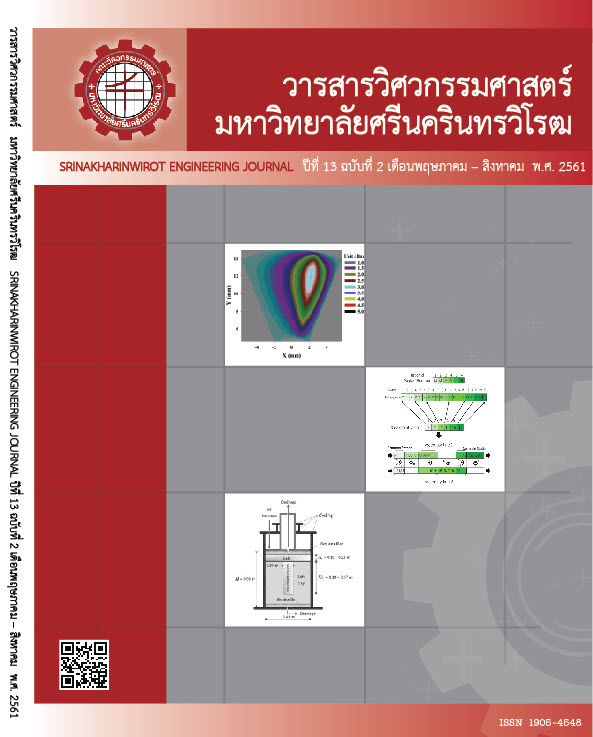Current Based Algorithm for the Maximum Power Point Tracking of Stand-alone Photovoltaic System
Main Article Content
Abstract
This paper present current based algorithm for the maximum power point tracking of stand-alone system. The proposed algorithm can improve the tracking performance compared with the conventional perturb and observe (P&O) method. The current based algorithm directly uses the change of photovoltaic current. As a result, the response and the achieved power are better than there of the P&O method. To verify the advantage of the proposed algorithm, the simulation via MATLAB and the experimental results from the hardware implementation are used. The results show that the current based algorithm can provide the better performance in both transient and steady-state response compared with the P&O method.
Article Details
Copyright belongs to Srinakharinwirot University Engineering Journal
References
[2] Ali F Murtaza, Hadeed Ahmed Sher, Marcello Chiaberge, Diego Boero, Mirko De Giuseppe and Khaled E Addoweesh, “Comparative Analysis of Maximum Power Point Tracking Techniques for PV applications”, Pakistan , Saudi Arabia and Italy, pp. 83-88, 2013.
[3] Mei Shan Ngan and Chee Wei Tan, “A Study of Maximum Power Point Tracking Algorithms for Stand-alone Photovoltaic Systems”,in IEEE Applied Power Electronics Colloquium (IAPEC), Malaysia, pp. 22-27, April 2011.
[4] ปทุมพร วงค์ใหญ่ กองพัน อารีรักษ์ และกองพล อารักษ์, “ระบบตามรอยกำลังสูงสุดสำหรับเซลล์แสงอาทิตย์แบบอิสระโดยใช้วิธีรบกวนและสังเกตที่มีการปรับตัว,” การประชุมวิชาการทางวิศวกรรมไฟฟ้า ครั้งที่ 38, อยุธยา, 18-20 พฤศจิกายน 2558.
[5] R. Boukenoui, R. Bradai, A. Mellit, M. Ghanes and H. Salhi, “Comparative Analysis of P&O, Modified Hill Climbing-FLC, and Adaptive P&O-FLC MPPTs for Microgrid Standalone PV System”, 4th International Conference on Renewable Energy Research and Applications (ICRERA), Palermo, Italy, 22-25 Nov 2015, pp. 1095-1099.
[6] Hanju Cha and Sanghoey Lee, “Design and Implementation of Photovoltaic Power Conditioning System using a Current based Maximum Power Point Tracking,” Chungnam National University, Korea, 2008.
[7] H. Toodeji, S.H. Fathi and N. Farokhnia, “Using Current-Based MPPT Method in New Integrated System of PV Module and STATCOM” 5th IEEE Conference on Industrial Electronics and Applications, Iran, pp. 1028-1033, 2010.
[8] Alivarani Mohapatra, Byamakesh Nayak and K.B.Mohanty, “Current Based Novel Adaptive P&O MPPT Algorithm for Photovoltaic System Considering Sudden Change in the Irradiance”, in IEEE International Conference on Power Electronics, Drives and Energy Systems (PEDES), 2014.
[9] I. William Christopher and Dr.R.Ramesh, “Comparative Study of P&O and InC MPPT Algorithms”, in American Journal of Engineering Research (AJER), Vol. 02, Issue. 12, pp. 402-408, 2013.
[10] L. Bouselham and B. Hajji, H. Hajji, “Comparative Study of Different MPPT Methods for Photovoltaic System”, ENSA-UMP, Morocco, 2015.
[11] Md Fahim Ansaria, S. Chatterjib and Atif Iqbalc, “A fuzzy logic control scheme for a solar photovoltaic system for a maximum power point tracker”, International Journal of Sustainable Energy Vol. 29, No. 4, pp. 245–255, Dec 2010.
[12] Jaw-Kuen Shiau, Yu-Chen Wei and Bo-Chin Chen, “A Study on the Fuzzy-Logic-Based Solar Power MPPT Algorithms Using Different Fuzzy Input Variables”, Tamkang University, Taiwan, pp. 100-127, 2015.

